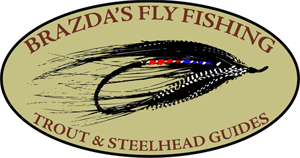Rivers Of Washington State
Olympic Peninsula Rivers
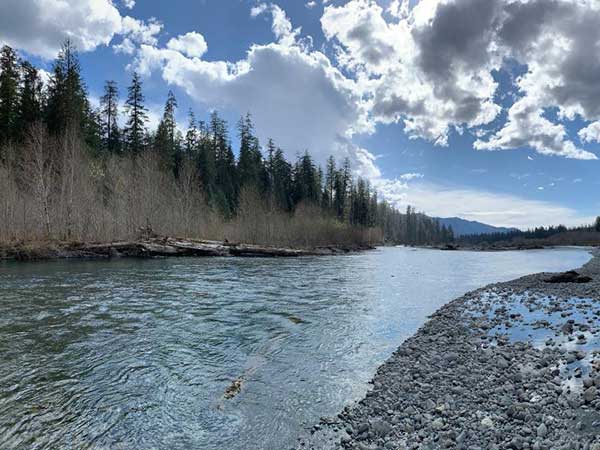
Hoh River
A beloved jewel. A must fish when fishable. As soon as you start the drive through the rain forest, you know you've entered a special place. With the ever present Elk herd alongside the road and the long flowing moss canopies, one gets the feeling of a relatively unchanged wilderness. The Hoh has the longest boat able selective fishery section, of all the rivers I fish. It even has a small "fly fish only section" in the lower park region. I cannot say enough about this system, and I suppose it is really the fish that make it great. It is possible to catch bright 20lb steelhead here as early as December and right through the season till closing. There are a good number of bull trout inhabiting the drainage so be very careful when encountering these prehistoric predators. The glorious thing about the Hoh is its ability to change. It has resisted mans attempt to contain it every time he tries. You can literally catch fish where three weeks earlier, there was a gravel bar 4 feet high. Entire log jams move within the system, one can actually recognize logs reappearing from within gravel bars, fished two decades before. It is a testament to the tenacity within Hoh river steelhead. The Hoh with its relatively short system, 38 miles mouth to glacier, produces massive steelhead. These fish love lumber, they can be found in the smallest side channel, clinging to log jams. They will move up the system at any time, low water, high water, it's as if the grey green water gives them a confidence to run and best of all to bite! With a good knowledge of reading steelhead water and a well presented fly any biters are soon found. It is my favorite for guiding when fishable.

Calawah River
A smaller sister to the Sol-Duc, this river has the ability of producing the largest, hardiest fighting steelhead on the Peninsula. With spectacular rapids, gin clear water and spooky steelies the Callawa demands the most from every angler. There are three sections to this gem, two divided by 101, and the ever-present bait and kill area boundary. The upper by intimidating rapids and an early closing of February 28th. A good percentage of my guiding is spent on all three sections. Below 101 calls for a long float and some class 111 water, ending in the Bogachiel at Wilson. With beautiful tail outs, long runs, and the entrance of the Bogy. This section swings best of the three. With the middle being so short, I often do a double float, taking out and finishing on another river. When the upper is open, it makes for a very fun and challenging float. All in all, the Callawa river will test you in every way.
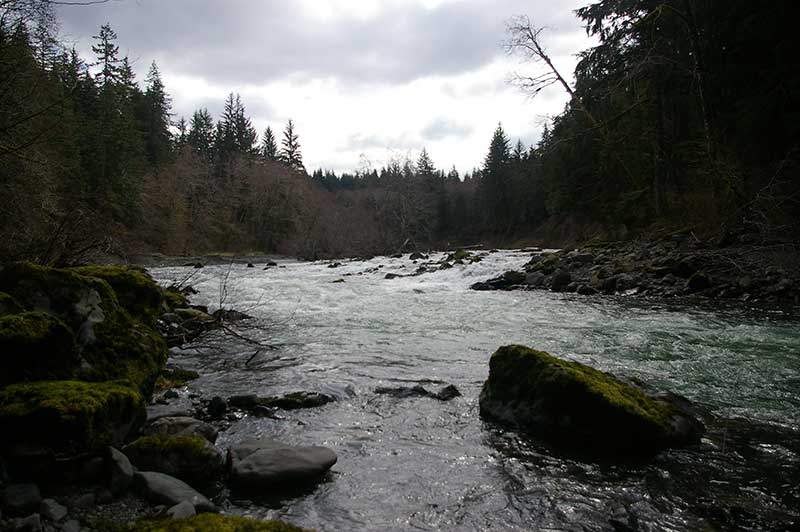
SOL DUC RIVER
The longest, strongest and most diverse drainage on the Olympic Peninsula. There is no comparison within our great state. The system hosts Chinook, Coho, Sockeye, a few Chum, Cutthroat (trout resident and sea run), resident Rainbow trout, summer run Steelhead, and winter run Steelhead all of which are wild runs. There are salmon hatcheries, and a brood stock hatchery for steelhead, but their influence upon the wild fish has been kept to an absolute minimal, ensuring the genetic diversity that will keep the runs strong. As with other rivers of the region, there is a huge refuge zone upstream of the selective fishing area, insuring wild spawning without interruption. I believe that the Sol-Duc is the perfect river for unparalleled steelhead production. It simply has it all, and I base a high percent of days on it.
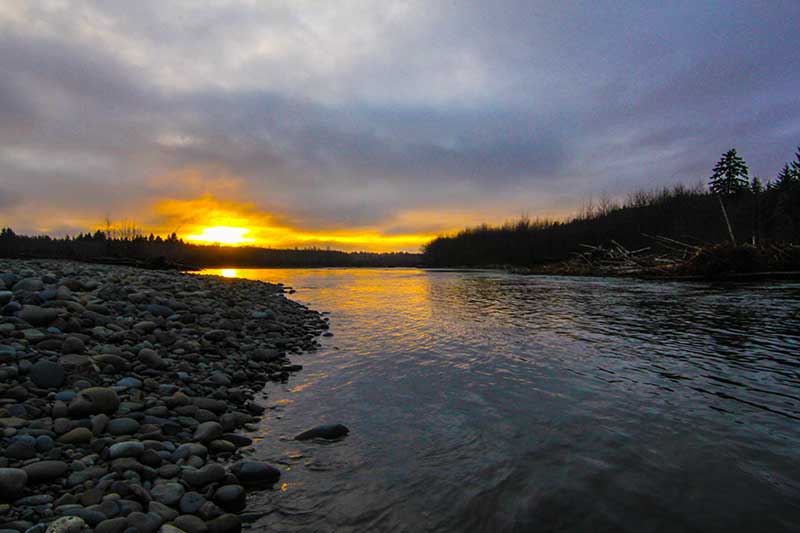
Bogachiel RIVER
Meaning "shiney waters", in the local tribal dialect, and is well deserved. Used primarily as the hatchery stream of the area it receives a lion's share of the fishing pressure. It has flat featureless water between the hatchery and Lyndeckers were it meets with the Sol-Duc to form the Quileute. On the other hand the water above 101 takes on a new look with large boulder strewn runs that invite the adventurous angler. This section again is a selective fishery, which greatly reduces the boat traffic. I consider this area a sleeper, and fish it on carefully selected days. Noted for large natives in late March and April the conditions during this time are at there optimum for the season.
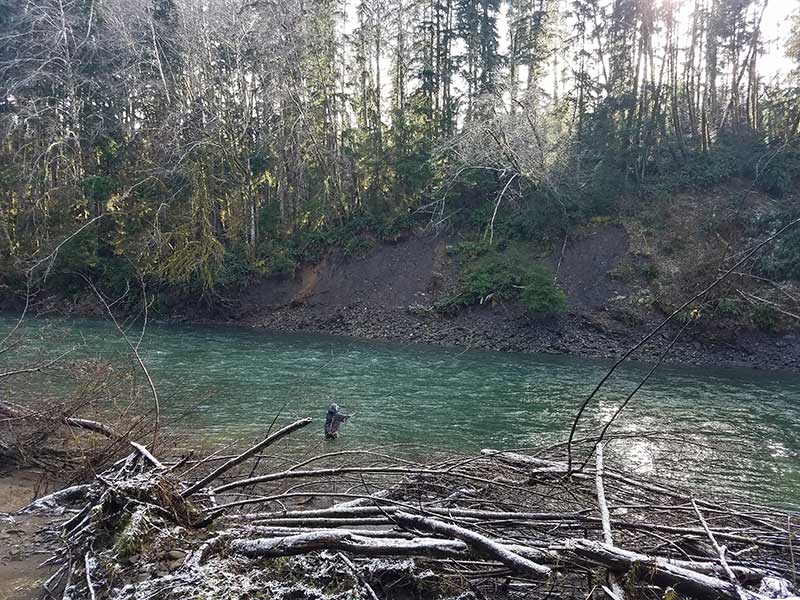
Clearwater RIVER
A relatively steep system that visibly increases in size at every mile. I only float one section on this river due to its inaccessibility. Known for large fish late into the season, it is a "must do" for those wanting to fish multiple days. The greatest thing about the river is its solitude, along with its beauty. One does not fish it for ten fish days, but rather one or two of great quality. For the swinger with a spey rod you can pick the best tail outs and enjoy the float inside a magnificent canyon. I love this river when I wish to relax and am fishing the swing.
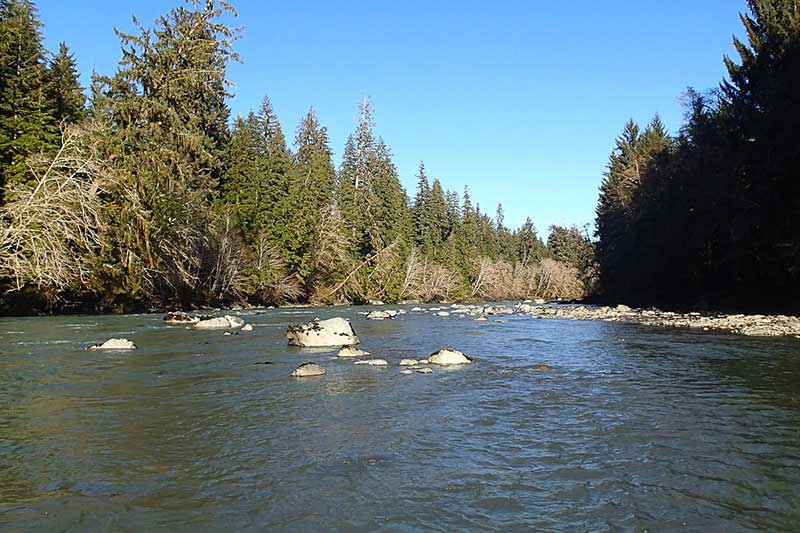
Queets RIVER
This rivers watershed is huge, and very politically endangered. Unfortunately, it has undergone regulation change after regulation change, and is also heavily fished by the Quinalt Indians. Just as it rebuilds itself, the catch and release is lifted, and it will receive huge pressure from the Aberdeen area all wanting to kill a 20. Until the politics subside, I will not fish it much. Keep your eye on the regs, it won't take long for these steelhead to populate after regulation change.
EASTERN WASHINGTON RIVERS
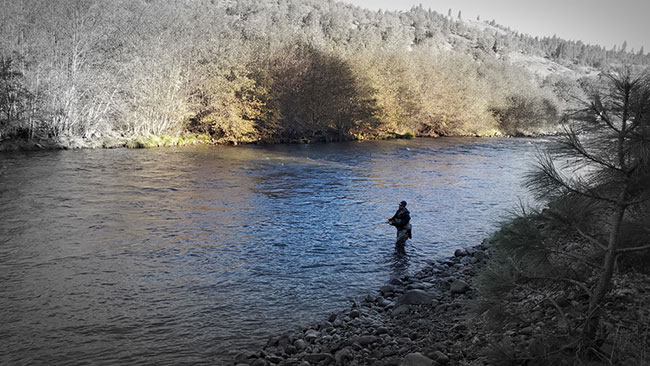
Klickitat River
The headwaters of the Klickitat originate in the eastern Cascades in the Goat Rocks Wilderness. The river gains flows from snowfields and glaciers on Mt Adams at 9000 ft elevation and combine with Big Muddy Creek to form the main Klickitat River. This river has many attributes form fast boulder runs in steep canyons to flat ledge rock strewn runs. It’s these lower river runs I’ve come to love the most for swinging a fly. Possibly the best attribute is super hard fighting and strong wild steelhead, rivaled by none on the West coast. The daunting falls near the mouth of the Klickitat has naturally selected the strongest of the species. These lower waters are protected by Forest service permits allowing only a small handful of guides to operate each season, offering limited access. The Yakama Indian tribe fishes at the falls May through November with dip nets. These lower river runs face south and finding shade in September can be challenging. Most seasons the fish trickle through all summer when turbidity is unfishable by sportsmen until around mid-August to mid-September. The first of the clear up can be the best swing fishing of the year, these fish love to chase and will hammer a swung fly recklessly. By mid-October when the Salmon are in their full swing of migration continuing into November, the egg drop becomes prevalent and swing fishing offers a little less action. At this time, the Canyon runs fill up with holding salmon and steelhead and our lower running sections get blown through in a day or two. November brings low fishing pressure, a mix of Coho and surprisingly large wild steelhead in all colors from shiny bright to double striped bruisers, both very clean and powerful. Many seasons we find the largest fish of the year around mid to late November. The river closes for spawning escapement November 30, this is the only relief from tribal netting they get since May. In recent seasons November has been the go to month with warmer temps in early fall, September turbidity and less anglers both sport and tribal.
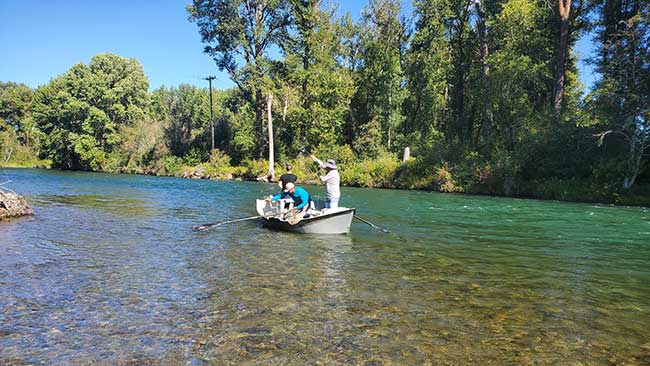
Yakima RIVER
No fishery in the state has changed so much in the past 15 years. The Yakima first came into my fishing world at the age of 7, when my grandfather took me on a float fishing trip through the lower canyon. We fished a full sink or a dry line then. On the dry, we fished this brand new pattern called a "Sofa Pillow", if that didn’t work it was a "Royal Coachman Hair Wing". On the sinking line we threw a "Mickey Finn or a Muddler", then the Muddler was also a dry fly. We only caught a few, but they were BIG, remembering back I am not so sure they weren’t steelhead. The Yakima is definitely divided into five substantially different sections or regions if you will, all with their own style. It is truly many rivers amongst one. It can be successfully fished with dry flies 8 or even 9 months a year, given appropriate flows. To this day I constantly learn something new about the Yakima and its fish. Spring and fall time is the best consistent hatch fishing, fishing on pods of rising fish. As summer progresses around the first full moon in June, we start to see the summer stone nymphs migrate to the shallows, soon after, the adults. It is these robotic little carnivores that make the Yakima a great fishery. Buy the full moon in July summer stones will be available in some form to the trout everyday. At the same time hoppers will be doing there thing as well as under the currents it’s a different migration of aquatic insects everyday. Now with most things in nature, bugs are cyclical and all seasons vary. So as for trout fishing up to the minute info is crucial for the best success.

Methow RIVER
The Methow valley is one of ancestral value for me. Both grandparents on my fathers side, were born and raised in the valley, their grandparents were pioneers of the local region settling in Winthrop and Twisp around the turn of the century. My great-great-grandmother came over on the Oregon trail as a little girl and lived in a log house, heated and cooked over a wood stove into her 90’s, and passed on, when I was 18, she was 104. My father was born in Twisp in 1945. The seed of outdoor life was definitely planted on the Methow. My very first introduction to fishing rivers was upon the Methow. Needless to say, I am very pleased that steelhead fishing has been opened up once again there. The very first steelhead I caught on a dry fly came to a large caddis some 18 years ago on the Met above Twisp. The fishing in the valley is but a hint of a time before dams. Whatever they are doing with the Columbia damns now is working, (draw downs in the spring to flush the smolt is my thought). With huge Chinook spawning throughout the system, large native cutthroat on the prowl, steelhead exist in every likely spot, and huge bull trout lurking, the Methow is returning to the fishery I remember as a young boy. I am sure my grandfather is looking on with a huge smile. The steelhead of the main stem originally were of the 15lb average, with various smaller subspecies utilizing upper reaches and tributaries. Now with hatchery influence, most of these fish are of the 4-8lb range, the larger native fish are all but extinct. These returning hatchery fish are the target, with a few wild natives thrown in. The fishery opens with a bang, as soon as announced by WDFW, sometime in October. The first few weeks can be a bonanza on the dry fly, if you have located the bulk of the run. The key is locating the fish, some years they may be in the lower stretches, holed up like a cattle rustling gang, hiding out. Others seasons they are stretched all the way to the boundary. Around November the weather will get cooler the salmon will finish spawning and the steelhead are suddenly alone. Perfect time to swing with a light spey rod and tips, with nothing to bother them, they become curious biters, not so many freight train grabs, sometimes its hardly noticeable, just an interruption in the swing. Experience will enable detection…..The Met is a river that should be experienced by every diehard fly fisher, not to many rivers offer steelhead with frequently caught incidental cutthroat and bull trout of substantial size. Wenatchee: Yes the Wenatchee. The rumor is that it may be opening back up in 2006. You can bet your bottom dollar I will be there. It was closed for good when I had just begun fishing it.

Naches River
The Naches watershed parallels the Yakima but is a much smaller drainage and is very particular to when it fishes well. It succumbs to irrigation removal with old school techniques often from heavy equipment piling berms into the river and pulling water unscreened from the main stem. I love to fish it, the Cutthroat are migratory up and down the river and often move into small colder upriver stretches and are unreachable most of the season. Of course they back down into larger water too, but again not easily reached by boat or bank. It’s these limitations that shorten the availability of guidable recreation on the Naches river. The spring runoff is imperative to the timing of good angling, 1000 cfs seems to be a great average in the lower stretch but I’ve fished it with good success down to 400 cfs with cool temps. Up around Whistlin Jacks Lodge, lower water is your friend and much less dangerous. The rainbows in the Naches are basically steelhead migrating either hatchery or wild. The Naches Cutthroat, some to very large size, are 100% wild and often feed on Salmon and other smolt. There are protected Bull trout present in the river, so we don’t fish streamers just to prevent these accidental encounters. When conditions are right, some very nice, large cutthroat are available commonly on dries or droppers of the stonefly brand. Short fast runs are the normal scenario, floating 10 miles is common and braids can cause headaches with fallen trees but a short walk may produce good catches. The summer stone hatch hits here about two weeks before it does on the Yakima in Ellensburg. By the time hoppers become available, it’s commonly too warm to fish for the sake of the trout. The Naches combines with the Tieton which is often muddy resulting in a large non angling section that runs all the way to the Yakima River in Yakima.
